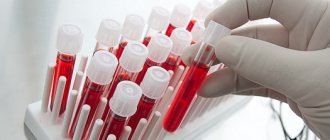Standards for interpreting analyses. The concept of reference values and reference interval.
The information obtained during laboratory analysis is based on the detection and / or measurement of certain components in clinical samples (biomaterial) of patients - analytes that are functionally or structurally related to a specific human organ or organ system. The most important component of any laboratory test is the interpretation of its result. In assessing the data obtained, a key role is played by establishing the difference between normal test results and pathology. In practice, this is not difficult to do if laboratory parameters clearly deviate from the values accepted as the norm. However, it is not always easy to divide most laboratory test results into “normal” and “pathological”, and therefore, in order to interpret them, it is necessary to compare the obtained data with the indicators established as the norm.
Normal test values (norm) are indicators found in healthy people. However, in groups of the latter they can have different values, that is, the norm is individual. This is due to both the individual physiological characteristics of the human body (peculiarities of metabolism, daily biological rhythms, the functional state of certain organs and their systems), and differences in gender, age, and physiological state. For example, during pregnancy, many biochemical indicators of a woman’s body change, so appropriate individual norms have been determined for pregnant women.
Normal laboratory values are determined in experimental clinical studies based on the results of measurements of the test analyte in a large population of healthy people, specially selected and grouped by age, sex or other biological and other factors. The obtained data lead to the average value, taking into account statistically possible standard deviations of its value. In this regard, it is more correct to talk not about the “norm” of a laboratory indicator, but about the range in which normal (reference) values are located. Therefore, at present, the term “norm”, which has already become familiar in assessing the results of laboratory tests, is used less frequently. Instead, they talk about reference (reference) values and the results obtained for a particular patient are compared with the so-called reference interval (range) . This term is more accurate because it gives an idea of the lower and upper limits of the norm of a laboratory indicator, possible, statistically reliable limits of fluctuation (deviation) of its value and, at the same time, emphasizes the relativity of these data, the possibility of application only to a certain group of people.
What are these antibodies?
As expected after vaccination, I checked IgG - a type of antibody that is responsible for immunological memory and remains in the blood after the active phase of the war with the virus is over. And these are, of course, antibodies to the coronavirus S protein. After an illness, they sometimes check for antibodies to the N-protein, but I shouldn’t have them, since I didn’t encounter the whole viral particle, but only a specific surface protein.
My test form says “neutralizing antibodies to the RBD domain of the S protein.” That is, in my blood they were looking not for any antibodies that could stick to the coronavirus particle (they are called binders), but only for those that would settle on the “master key” with which the virus should contact the cell and prevent it from penetrating inside (but these are already neutralizing). Strictly speaking, in an ordinary commercial laboratory no one checks whether, under the influence of my antibodies, the virus will not be able to infect cells - this is quite time-consuming and expensive, you will need to grow a cell culture and keep a supply of coronavirus (or its analogue, pseudovirus) on hand.
Therefore, a simpler test system is used: a known amount of ACE2 receptors is placed on a plate (a “lock” for the virus), and blood plasma and a known amount of the luminous RBD domain of the S protein (“master key”) are poured into the solution. After some time, you can pour out the liquid and see how many luminous master keys still got into the keyholes - and convert this into the concentration of antibodies. This parameter correlates with the results of tests on cells, and is thought to be useful as a measure of neutralization - although it is likely that not all antibodies that show up in such a surrogate test will be sufficiently sticky and persistent in real cellular life.
Analysis decoding. Normal or pathological?
When establishing a reference range, mathematical and statistical approaches are used, according to which the values of the results of laboratory tests of a certain analyte of 95% of healthy people fall within the established interval. Accordingly, for 5%, the values of the analyzed indicators are outside the established range. In other words, in 5% of cases, “abnormal” laboratory parameters are detected in healthy people, which should be taken into account when interpreting the analysis. This is explained by a number of reasons.
Firstly, the division of the biological population of people into “sick” and “healthy” according to many laboratory indicators is very conditional. Being statistical data, the limits of normal laboratory values may vary. Therefore, it happens that in healthy people, certain indicators that are the “norm” for them are not ultimately the “norm” for the majority of others, and therefore do not fall within the range of generally accepted reference values. In this case, the limits of the reference range cannot serve as absolute indicators of health or disease.
On the other hand, the disease often develops unnoticed, manifesting itself as a gradual transition from small deviations in laboratory parameters to higher values as dysfunction and severity of the disease increases. In this regard, when deciphering tests and interpreting the results of laboratory tests, it becomes very important for the clinician to assess the dynamics of changes in a specific laboratory indicator in a specific patient. In doubtful cases, the main criterion for the presence or absence of the disease is clinical symptoms or the degree of its severity. If there are symptoms of the disease, additional laboratory tests are used for diagnosis using highly sensitive and specific tests that most significantly change their values against the background of the suspected disease.
Secondly, “healthy” and “sick” people actually belong to two different populations, and when these populations are mixed with each other, it is almost impossible to recognize each of them in the total mass. In addition, in different patients, the same indicator can not only take on different values, but also overlap the values of this indicator in healthy people. Moreover, for different indicators, different diseases, different groups of patients, the magnitude of this “crossover” can vary greatly: from too small, which can be neglected, to very significant, when a special approach and careful analysis of all data is required to classify the result as “normal” or "pathological". The latter is extremely important to take into account when assessing the results of laboratory tests, since in this case not all values outside the normal range will indicate the presence of pathology. The range of values in which the laboratory parameters of “sick” and “healthy” individuals overlap is called the zone of uncertainty, or the “gray zone”. It exists for a number of laboratory techniques, but is most often found in the results of enzyme immunoassays. If a result falls into the “gray zone,” it cannot be unambiguously regarded as either normal or pathological and is considered doubtful. In such a case, the patient is usually recommended to repeat the diagnostic test 2 to 4 weeks after receiving an indeterminate result.
And finally, an indicator lying in the reference interval cannot always be considered normal, since the range of many of them is quite wide. For example, the normal hematocrit (Ht) value in men varies from 42 to 52%. Massive blood loss can lead to a drop in this indicator from 52 to 42%, while the value of 42% remains within the range of reference values, and therefore may not cause alarm to doctors. However, in a certain situation, for a particular patient, such a decrease in hematocrit can not only be clinically significant, but also be critical.
Thus, results within the reference range are not always the norm. And, on the contrary, results that go beyond the reference values are not always a pathology, but only a significant prognostic sign that can signal a possible pathological process. In this regard, in laboratory diagnostics an approach is becoming increasingly widespread when the most significant and adequate reference values for each individual patient should be considered the stable results of his laboratory tests obtained over several years. Even now, experts all over the world are inclined to believe in the need to “lower” the importance of reference intervals, moving away from treating them as some kind of “absolute” criterion for assessing a laboratory result. This circumstance in no way reduces the importance of laboratory research. They remain the most important tool for diagnosing pathological conditions, monitoring the course of diseases, identifying the preclinical stage of diseases during screening examinations, and also largely determine the further tactics of diagnostic procedures and making treatment decisions. However, this approach directs the clinician to a more cautious use of reference values in assessing “normal” and “pathological” results, indicating the need for their interpretation taking into account possible biological variation in the population, taking into account data from the clinical picture and other types of studies in the aggregate, and also those factors that may influence the results of laboratory tests.
Reference ranges
Currently, reference values have been established for many laboratory parameters. The results of some types of tests are given to the patient in the form of “yes” or “no”. This type of research is qualitative. For example, a positive result for antibodies to a certain infection indicates the presence of these antibodies in the patient’s blood and may indicate infection. In the case where the research was quantitative, the result is given in the form of a digital value indicating the units of measurement and the corresponding reference range on the form. For example, the results of a biochemical study to determine the level of C-reactive protein (CRP), which is a marker of inflammation, may look like this: 0.4 mg/l, reference values: 0 – 6 mg/l. From the above example it is clear that the result obtained is within the established reference range. For most laboratory indicators, the range of reference values is indicated taking into account the patient’s gender and/or his membership in a certain age group. For example, reference values for serum creatinine for children under 1 year of age are 18 - 35 µmol/l, for children from one to 14 years old - 27 - 62 µmol/l, and for persons over 14 years old - 62 - 115 µmol/l for males and 53 - 97 µmol/l for females.
The influence of age and gender on the reference range is significant for many laboratory tests. For example, the concentration of alkaline phosphatase, a key enzyme secreted by bone tissue cells, increases in proportion to the rate of formation of new cells. Therefore, in children and adolescents, high levels of this enzyme are not only normal, but also desirable, since they are associated with active bone formation and growth. On the contrary, a high level of alkaline phosphatase in an adult may indicate developing osteoporosis, metastases of bone tumors or other pathological processes. The exception is pregnant women, who are characterized by a physiological increase in the activity of this enzyme, especially in the third trimester of pregnancy.
2.Why is this done?
A blood test for immunoglobulin is done in order to:
- Find a specific allergy or autoimmune disease;
- Find certain types of cancer (multiple myeloma or macroglobulinemia);
- Determine whether relapse of diseases is the result of low immunoglobulin levels;
- Check the progress of treatment for bone marrow cancer;
- Check the progress of treatment for the bacterium helicobacter pylori;
- Check the immunization process;
- Check to see if you have or have had an infection before.
An immunoglobulin test is performed when the electrophoresis or total blood protein test results are abnormal.
Why may reference ranges vary between laboratories?
Different diagnostic laboratories use different types of laboratory equipment to perform analysis, for example, biochemical and immunochemical analyzers, the range of which is currently very wide, work on reagents from different manufacturers, and in addition, they may use research methods that are different from other laboratories. In this regard, each laboratory indicates on the results form its ranges of reference values, in establishing which it is guided, of course, by generally accepted standards, but taking into account the individual characteristics of its work: the specifics of the equipment used, the methods of analysis used and the units of measurement. That is why the ranges of reference values for the same laboratory test can vary according to data from different diagnostic laboratories, and there is no such thing as a “single” reference range. When assessing the results of laboratory tests, the attending physician must first of all refer to the range of reference values indicated on the form of the laboratory in which the analysis was performed. In order for the interpretation of the results to be correct and their comparability to be observed, especially in the case of repeated studies, for example, when monitoring therapy or dynamic assessment of the patient’s condition, it is advisable to conduct studies using the same method, in the same laboratory and, if possible, other things being equal.








